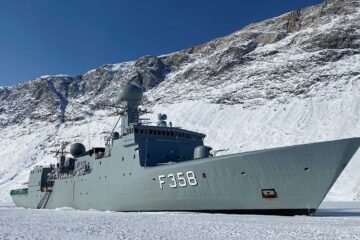In June 2023, the Norwegian Ministry of Defence published The Military Advice of the Chief of Defence 2023, in which General Eirik Kristoffersen (Chief of Defence) recommended that Norway replace the RNoN’s in-service Fridtjof Nansen-class frigates and increase the force level to six ships.
The RNoN currently operates four Fridtjof Nansen frigates. HNoMS Helge Ingstad – fourth in the five-ship class – was scrapped following a 2018 collision with a tanker off Bergen, when the frigate sustained major damage.
Delivering a new frigate likely will be central to the government’s long-term plan to build a new surface force structure within a wider fleet renewal programme, Rear Admiral Oliver Berdal, the RNoN’s Chief of Navy, told Naval News.

The complexity of the evolving threat at sea, plus wider regional and global instability, is driving a focus on co-operative capability for acquisition and sustainment, Rear Adm Berdal explained. When presenting its long-term plan to parliament, which is scheduled to happen in 2024, the government likely will emphasize the need to deliver the future frigate through partnership, he added.
Particularly, the RNoN does not wish to be the only navy operating that frigate type, Rear Adm Berdal explained. “I think a partnership is essential: we will not build a frigate alone.”
In acquisition and build terms, the admiral continued, the aim will most likely be to “jump into a production line and end up with the same ship that navy is building”. The intent will be to develop a frigate as close to 100% identical as possible with the partner’s platform, he said.
“Ideally, the more identical the better, for synergies and economies of scale. Any difference in design or system terms will increase the cost, not only in acquisition, but also life cycle,”
“There might be some differences, but they should be kept to a minimum. That is the essence of partnering.”
Rear Admiral Oliver Berdal, RNoN’s Chief of Navy

Partnering could extend to major refits. Mid-life upgrades, for example, could be carried out where the ship was built, said Rear Adm Berdal. While routine maintenance should take place in Norway to ensure national industrial involvement and to enhance operational availability and readiness, this maintenance work could be supported through partnering, too.
“We have to get the balance right …. My interest is in the effect and total output,” said Rear Adm Berdal. “Whatever model suggests the best possible way is what I will be championing.”
In operational terms, while the RNoN’s overall requirement is for a multidomain frigate covering anti-air warfare, anti-surface warfare, and land-attack roles, “for Norway, the most important point is that the anti-submarine warfare (ASW) capability is good,” said Rear Adm Berdal. Here, he explained, the increase in threat in the RNoN’s areas of operation means the navy needs more ASW capability now than it has had at any point over the last 30 years.
“The ASW threat is increasing. Modern, capable submarines are very hard to find, track, and defeat,”
“To counter this threat, we need to fully utilize new technology, ranging from enhanced performance on traditional ASW sensors, to using artificial intelligence [and] unmanned systems in all domains, and combining the best of all available technologies to succeed.”
Rear Admiral Oliver Berdal
Increasing the frigate force to six will also bolster future ASW capability. Adding platform capacity will enhance Norway’s ability to secure its significant coastline and regional patrol areas, while supporting its global maritime interests (which include substantial oil and gas exports, plus one of the world’s largest shipping fleets). “There is much to protect and much to defend,” said Rear Adm Berdal. “The RNoN must be capable of securing Norway and Norwegian interests, as well as contributing to NATO and freedom of navigation at sea. These tasks will not go away: on the contrary, at the moment the need seems to be increasing.”
Partnering again will be important for the RNoN in generating operational output, including for training and deployments. Here, Rear Adm Berdal highlighted the RNoN’s close relationship with the UK Royal Navy (RN). “This relationship has been very strong and important for the RNoN,” he said.
Nonetheless, currently the RNoN has no set partner for delivering the frigates. “When it comes to a potential future partnership … the government will have to conduct a thorough analysis of several important aspects to ensure the potential future frigate procurement meets the goals and gives Norway the best possible frigates in the best possible partnership,” said Rear Adm Berdal. “At this point in time, it is too early to make any qualified assessments on various partners.”
Currently, there is no set deadline for delivering the future frigates either. There are several steps to take over several years prior to setting any deadline, Rear Adm Berdal explained. These steps include receiving parliamentary approval for the long-term plan, establishing the potential procurement plan as a formal project, and maturing work to the point of completing external quality review to demonstrate project readiness for execution prior to seeking further parliamentary approval. Meanwhile, the Fridtjof Nansen frigates will undergo refit to ensure they can remain operational and capable until the new frigates arrive, the Chief said.






